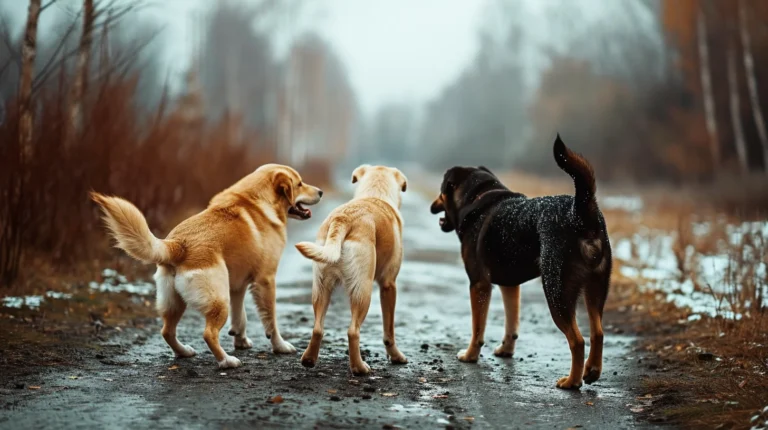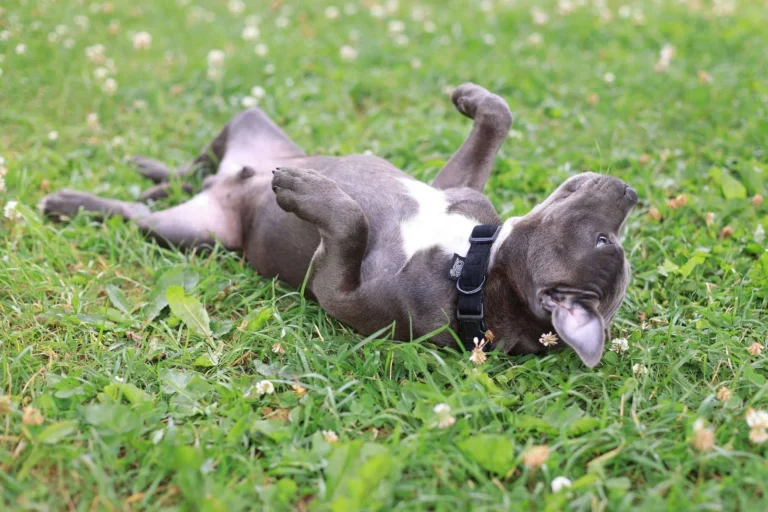How to Stop Your Dog From Jumping Up
Help us help more people and dogs by sharing this post:
Introduction
Imagine this scenario: You’re coming home after a long day, and your enthusiastic dog can’t contain their excitement. They leap towards you, paws aiming for your chest. Although their enthusiasm is heart-warming, those sudden jumps can be overwhelming and dangerous, especially with guests around.
But fear not! In this article, we’re diving deep into the world of dogs and their jumping habits. We’ll explore why it happens, why it’s crucial to address, and most importantly, how to put a stop to it.
Dogs jumping up on people is a common issue faced by pet owners, but it’s more than just an inconvenience. It’s essential to tackle this behaviour for both the safety of your pup and the comfort of the people around them. Nobody wants to be knocked over by an overzealous dog!
So, our mission here is clear: equip you with effective strategies to train your dog not to jump on people. Whether you’re experienced or new to owning a dog, we have effective and kind methods to control their jumping. So, let’s get started on the journey to a well-behaved, polite, and happy dog!
Understanding why dogs jump up at people:
Now that we’re on our mission to curb those airborne doggy greetings, it’s essential to first get inside the mind of a dog. Why do they jump up in the first place? Understanding the “why” is crucial in addressing this behaviour effectively.
Dogs, much like humans, have their reasons for everything they do. For jumping, it often boils down to a mix of excitement, the desire for attention, and some ingrained canine instincts.
- Excitement: Dogs are naturally excitable creatures, and when they see someone they love – that’s you! – their excitement levels can skyrocket. Jumping becomes their way of expressing that sheer joy. It’s like they can’t contain their happiness, and they want to get as close to you as possible.
- Attention-Seeking: Your dog might jump up simply because they want your attention. In their world, any interaction with you is a win, and what better way to grab your focus than by leaping into your personal space? It’s their version of saying, “Hey, look at me!”
- Canine Instincts: From an evolutionary perspective, dogs have instincts that lead them to jump up. In the wild, puppies would jump up to greet their mother and lick her face as a sign of submission or to ask for food. This behaviour can carry over into their interactions with humans.
- Breed and Temperament: some breeds are more prone to jumping than others. For instance, energetic and friendly breeds like Retrievers and Boxers may be more inclined to jump out of sheer enthusiasm. Additionally, an individual dog’s temperament plays a role. Some dogs are naturally more reserved, while others are outgoing and exuberant.

Understanding these underlying reasons for jumping is the first step in addressing the issue effectively. In the next sections, we’ll discuss strategies to help you train your energetic dog to be well-behaved and polite
The Impact of a Dog Jumping Up:
Now let’s look at the consequences of our dogs’ jumping behaviour for both humans and dogs.
- Dogs jumping on people can cause physical harm. Jumping dogs can accidentally scratch or injure people, especially children and older adults, who may not be as stable on their feet. A playful leap that was meant to be affectionate can quickly turn into an unintentional collision.
- Behavioural Implications for dogs: For our four-legged pals, jumping can also have behavioural implications. If they keep jumping without correction, they might not learn what behaviour is acceptable. This can lead to a host of other behavioural issues, as they may not respond to commands or respect personal space.
- Social Consequences: In the world of human-dog interactions, not everyone appreciates a canine cannonball greeting. Friends, family, or even strangers can feel uncomfortable or even frightened when a dog jumps on them. This can strain relationships and limit the social opportunities for your dog.
- Safety Concerns: In a more serious vein, jumping dogs can pose a danger in certain situations. For instance, a jumping dog can be hazardous when someone is entering or exiting your home, as it may lead to trips and falls.
Understanding these impacts is crucial because it highlights the urgency of addressing the jumping behaviour. It’s not just about maintaining polite manners; it’s about the safety and comfort of both your dog and the people they interact with. In the upcoming sections, we’ll equip you with actionable strategies to ensure that those joyful greetings are transformed into more controlled and safe interactions.
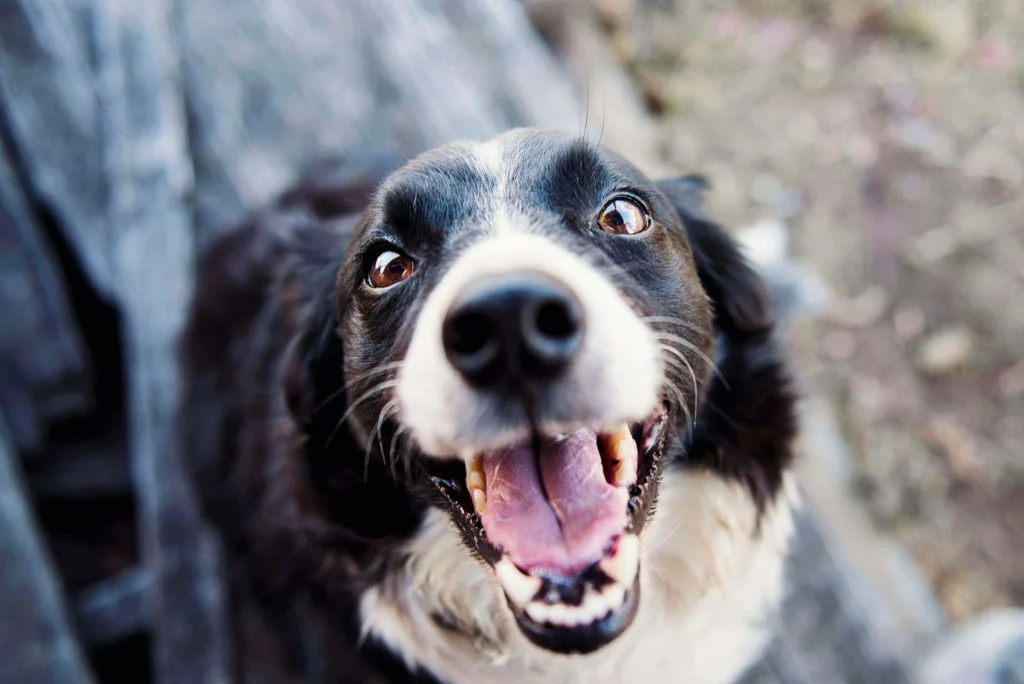
Training Basics: Teach Your Dog Not to Jump Up
With a clear understanding of why dogs jump and the potential consequences, it’s time to roll up our sleeves and delve into the fundamentals of training. The path to a well-behaved, non-jumping dog begins here.
Consistency is Key: When it comes to dog training, consistency is the name of the game. Your dog thrives on routine and predictability. Ensure that everyone in your household is on the same page when it comes to training commands and expectations. Mixed signals can confuse your dog, making it harder for them to learn.
Positive Reinforcement: Imagine being rewarded with your favourite treat or a pat on the back every time you did something right. Dogs thrive on positive reinforcement. When they exhibit the behaviour you want – in this case, not jumping – reward them with praise, treats, or affection. This positive association will encourage them to repeat the desired behaviour. Teaching them to sit is an enormous advantage. When a dog jumps, telling them to sit and rewarding them when they do is positive reinforcement. It will teach your dog that sitting in front of you is more beneficial than leaping on you. Ensure your dog knows that the reward comes from sitting, not from the chained actions of jumping up and then sitting.
Patience is a Virtue: Training takes time, and it’s essential to be patient with your dog. They won’t become a model citizen overnight, but with consistent, positive reinforcement, they’ll get there. Avoid punishing your dog for jumping, as this can lead to confusion and anxiety and weaken the trust your dog has in you.
Start Early: The earlier you start training, the better. Puppies are like sponges, soaking up information and habits quickly. However, it’s never too late to teach an old dog new tricks. No matter the age of your dog, consistent training can yield positive results.
Owner’s Attitude and Behaviour: Remember that your attitude and behaviour play a significant role in your dog’s training. Stay calm and composed during training sessions. Dogs pick up on your emotions, so if you’re frustrated or anxious, it can hinder their progress. Maintain a positive, encouraging demeanour.
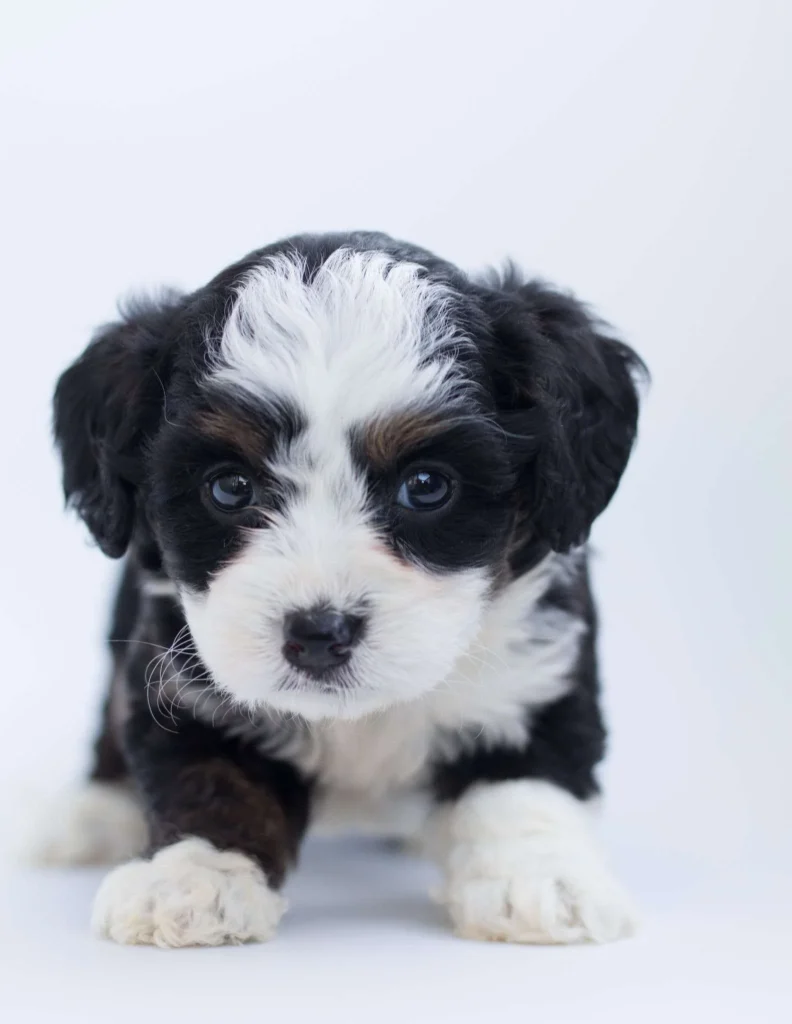
In the next section, we’ll dive into specific strategies and techniques to teach your dog not to jump on people. By following these training principles and staying committed, you can turn your jumping dog into a well-behaved companion.
Training Techniques to Discourage Jumping:
Now, let’s dive into the nitty-gritty of specific training techniques to discourage jumping in your dog. These steps, when followed with consistency and patience, can be highly effective:
The ‘Sit’ Command:
Start by teaching your dog the ‘sit’ command. This is a fundamental skill that’s essential in preventing jumping.
Hold a treat above your dog’s head, and slowly move it backward while saying “sit.” As your dog follows the treat with their nose, their rear end should naturally lower to the ground.
When your dog sits, immediately reward them with the treat and praise. Consistency is key here, so use the same command and hand signal every time. The hand signal is also crucial in environments where your dog may not hear you, or if it becomes deaf with age. Teaching both hand and voice commands is highly beneficial for your dog.
Ignoring the Jumping:
If your dog jumps on you or someone else, resist the urge to react. Instead, become a “tree.” Cross your arms, avoid eye contact, and turn your back on your dog.
As soon as your dog’s paws touch the ground, even if it’s just for a second, immediately give them attention, treats, and praise. This reinforces the idea that jumping doesn’t get them what they want. Even better – wait until they sit.
Redirecting Behaviour:
Another effective technique is redirecting your dog’s behaviour. When they jump, offer them a toy or treat. This redirects their attention and energy towards an appropriate activity.
Praise and reward them when they engage with the toy or treat, reinforcing that calm behaviour is more rewarding than jumping.
Using Treats and Praise:
Treats and praise are powerful motivators. Use them generously when your dog behaves as desired.
Whenever your dog remains calm and doesn’t jump when greeting someone, give them treats and praise right away. Positive reinforcement strengthens the desired behaviour.
Consistency and Repetition:
Consistency is the golden rule of dog training. Ensure that everyone in your household follows the same training methods and commands.
Repetition is also key. Practise these techniques often, especially during greetings or situations when your dog jumps. Over time, the behaviour will become ingrained.
Practice in Controlled Settings:
Initially, practise these techniques in a controlled setting with minimal distractions. As your dog becomes proficient, gradually introduce more challenging situations and environments.
Stay Calm and Patient:
Dogs can pick up on your emotions. Stay calm and patient during training sessions. If you get frustrated, it can impede progress.
Remember that training takes time, and setbacks are normal. Stay consistent and keep reinforcing the desired behaviour.
By following these steps, you’ll be well-equipped to discourage jumping in your dog and encourage more polite greetings. With time and practice, your dog will learn that sitting calmly is the way to go, earning them all the attention and rewards they crave.
Preventive Strategies:
It’s easier and more effective to stop jumping before it becomes a habit. Let’s explore some proactive measures to keep those puppy jumps in check:
Early Training and Socialisation:
The foundation for preventing jumping starts early in your dog’s life. Begin training and socialising your puppy as soon as possible. Expose them to a variety of people, animals, and environments. This helps them learn appropriate behaviour and how to interact with different situations calmly.
Manage Excitement: Dogs are bundles of energy, and managing their excitement levels can be key to preventing jumping. Here are some tips to both manage excitement and help your dog to understand what is wanted from him or her:
- Regular Exercise: Ensure your dog gets enough physical and mental exercise. A tired dog is less likely to engage in hyperactive behaviour.
- Structured Playtime: Engage in structured play sessions that focus on obedience training and impulse control. This can help them learn self-discipline.
- Calm Greetings: Teach your dog to greet people calmly from the beginning. Encourage them to sit or stand quietly when meeting new people. Reward calm behaviour with treats and affection. Positive reinforcement training techniques will always pay off.
- Set Clear Boundaries: Consistency is essential in setting clear boundaries for your dog. Establish rules early on and enforce them consistently. For instance, if you don’t want your dog on the furniture, make sure everyone in the household follows this rule.
- Use Baby Gates or Crates: When you have guests over or during particularly excitable times, consider using baby gates or crating your dog to prevent them from jumping on people. This can help avoid reinforcement of the behaviour.
- Positive Reinforcement for Good Behaviour: Reward your dog for exhibiting desired behaviour. If they greet someone without jumping, shower them with praise, treats, or toys. This reinforces the idea that staying calm leads to positive outcomes.
- Training Classes: Enrolling in obedience training classes can be highly beneficial for both puppies and adult dogs. Professional trainers can guide you in preventing unwanted behaviours, including jumping.
- Consistency with Visitors: Educate your guests on how to interact with your dog. Ask them to wait for your dog to calm down before giving attention. Consistency in handling visitors can prevent mixed signals.
By implementing these preventive strategies and starting early, you can set your dog on the path to becoming a well-behaved companion who greets people politely. Remember that patience and positive reinforcement are your allies in fostering the best behaviour in your furry friend.
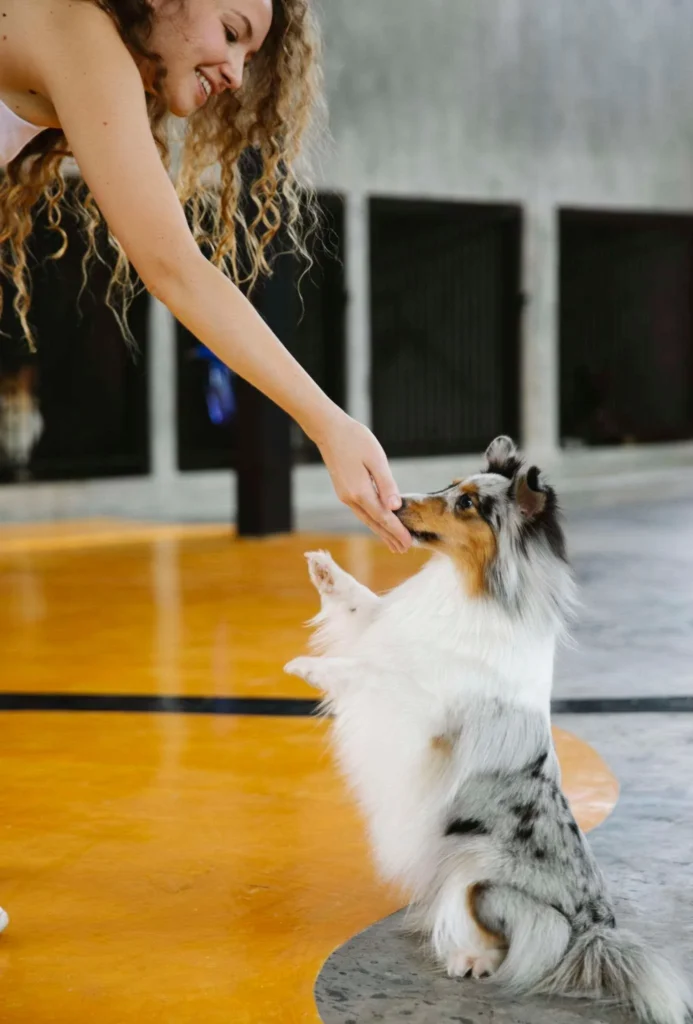
Beware:
Avoiding common mistakes and understanding what not to do is just as crucial as knowing the right training techniques. Let’s explore some pitfalls to avoid when training your dog not to jump:
- Avoid Punishment: Using punishment or physical corrections is not effective and can be harmful. Yelling at your dog, using physical force, or resorting to aversive methods can create fear and anxiety. It may lead to aggression or other behavioural issues. It’s not kind.
- Don’t Encourage Jumping: Be careful not to inadvertently reward jumping. If you pet or give attention to your dog when they jump, even to push them away, they may see it as a form of interaction and continue the behaviour.
Avoid Inconsistency: Consistency is paramount in training. Inconsistency in commands and responses can confuse your dog. Ensure that everyone in your household follows the same rules and uses the same verbal and hand commands. - Avoid Inconsistency: Consistency is paramount in training. Inconsistency in commands and responses can confuse your dog. Ensure that everyone in your household follows the same rules and uses the same verbal and hand commands.
- Don’t Give Up Too Soon: Training takes time, and progress may be slow initially. Don’t give up or become frustrated if your dog doesn’t immediately respond. Keep practicing and reinforcing desired behaviours.
- Avoid Rough Play: While playtime is essential for a dog’s well-being, rough play that encourages jumping can reinforce the behaviour. Encourage gentle play and redirect their energy toward toys.
- Don’t Use Harsh Tools: Avoid using tools like shock collars or prong collars to stop jumping. These can cause physical and psychological harm to your dog and should not be part of a positive training approach.
- Don’t Ignore the Behaviour: Ignoring your dog when they jump is a training technique, but it should be applied strategically. Don’t ignore the behaviour altogether without providing clear guidance on what you expect from your dog.
- Avoid Stressful Situations: If your dog becomes anxious or stressed during training, take a step back and reassess your approach. Training should be a positive and enjoyable experience for both you and your dog.
- Don’t Skip Socialisation: : Socialising your dog is essential but avoid overwhelming them in unfamiliar or chaotic environments. Gradually introduce new experiences and people to prevent anxiety or fear-based jumping.
Remember that training should be based on positive reinforcement, consistency, and patience. Avoiding punitive measures and common mistakes will lead to a more successful and harmonious training experience for you and your pet.
Seeking Professional Help to Prevent Your Dog From Jumping Up:
Sometimes, dog owners may need professional help to address jumping behaviours. Here’s when and how to consider seeking help from a professional dog trainer or behaviourist:
When to Consider Professional Help:
- Persistent or Aggressive Jumping: : If your dog’s jumping behaviour persists despite your best efforts or becomes aggressive in nature, it’s time to consult a professional.
- Safety Concerns: If the jumping poses a safety risk to you, your family, or your dog (especially with children or older individuals), professional intervention is essential.
- Multiple Behavioural Issues: : If your dog exhibits other behavioural problems in addition to jumping, such as aggression, anxiety, or fearfulness, a behaviourist can provide comprehensive guidance.
Lack of Progress: If you’re not seeing progress in your training efforts or if your dog’s behaviour worsens, it’s an indicator that professional help may be needed.
What to Expect from Professional Training Sessions:
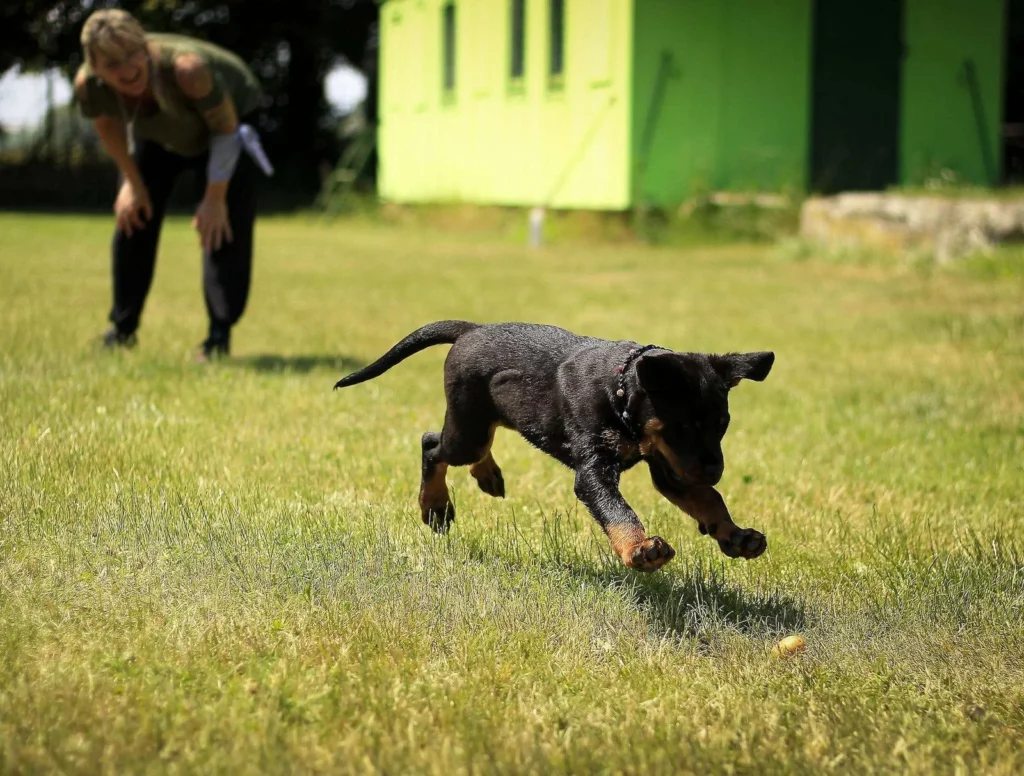
- During professional training sessions, you can expect a customised approach tailored to your dog’s specific needs and behaviour.
- The trainer or behaviourist will assess your dog’s behaviour, identify triggers for jumping, and develop a training plan.
- They will provide hands-on guidance, demonstrate techniques, and work with you to implement them effectively.
- Trainers and behaviourists will oversee progress and make changes to the training plan if necessary to achieve desired results.
- You will receive advice on how to maintain the training at home and continue reinforcing the desired behaviour.
- In summary, individuals should consider professional help when jumping behaviour persists, poses safety concerns, or is accompanied by other behavioural issues. Working with certified and reputable professionals ensures your dog receives effective and ethical training to address the problem successfully.
Final Thoughts:
In this guide, we’ve explored the common issue of dogs jumping up on people and provided you with effective strategies to address this behaviour. Let’s recap the key points:
- Understanding Why Dogs Jump Up on People: We delved into the reasons behind jumping, such as excitement and attention-seeking, and discussed how breed and temperament play a role.
- The Impact of Jumping: We highlighted the potential risks and negative impacts of jumping on both humans and dogs, emphasising the importance of addressing this behaviour.
- Training Basics: We covered essential training principles, including consistency, positive reinforcement, patience, and the role of the owner’s attitude and behaviour in training.
- Preventive Strategies: We discussed proactive measures like early training, socialisation, and managing excitement levels to prevent jumping from becoming a habit.
- Training Techniques to Discourage Jumping: We provided steps for specific training techniques, such as the ‘sit’ command, ignoring jumping, and redirecting behaviour.
- What Not to Do: We highlighted common mistakes to avoid, explained why punishment is ineffective and harmful, and emphasised the importance of not inadvertently rewarding jumping.
- Seeking Professional Help: We discussed when to consider professional help, what to expect from professional training sessions, and the significance of working with certified and reputable professionals.
Going forward, remember that patience and consistency are critical. Training takes time, and setbacks are normal. Stay committed to positive reinforcement and clear communication with your dog.
We also encourage you to share your own experiences and tips in the comments section. Learning from each other’s successes and challenges can be immensely valuable in creating a community of informed and responsible dog owners.
With dedication, love, and these proven strategies, you can transform your jumping dog into a well-mannered, polite, and joyful pet. Here’s to many happy and jump-free moments with your best friend!
Frequently asked questions:
Help us help more people and dogs by sharing this post.


